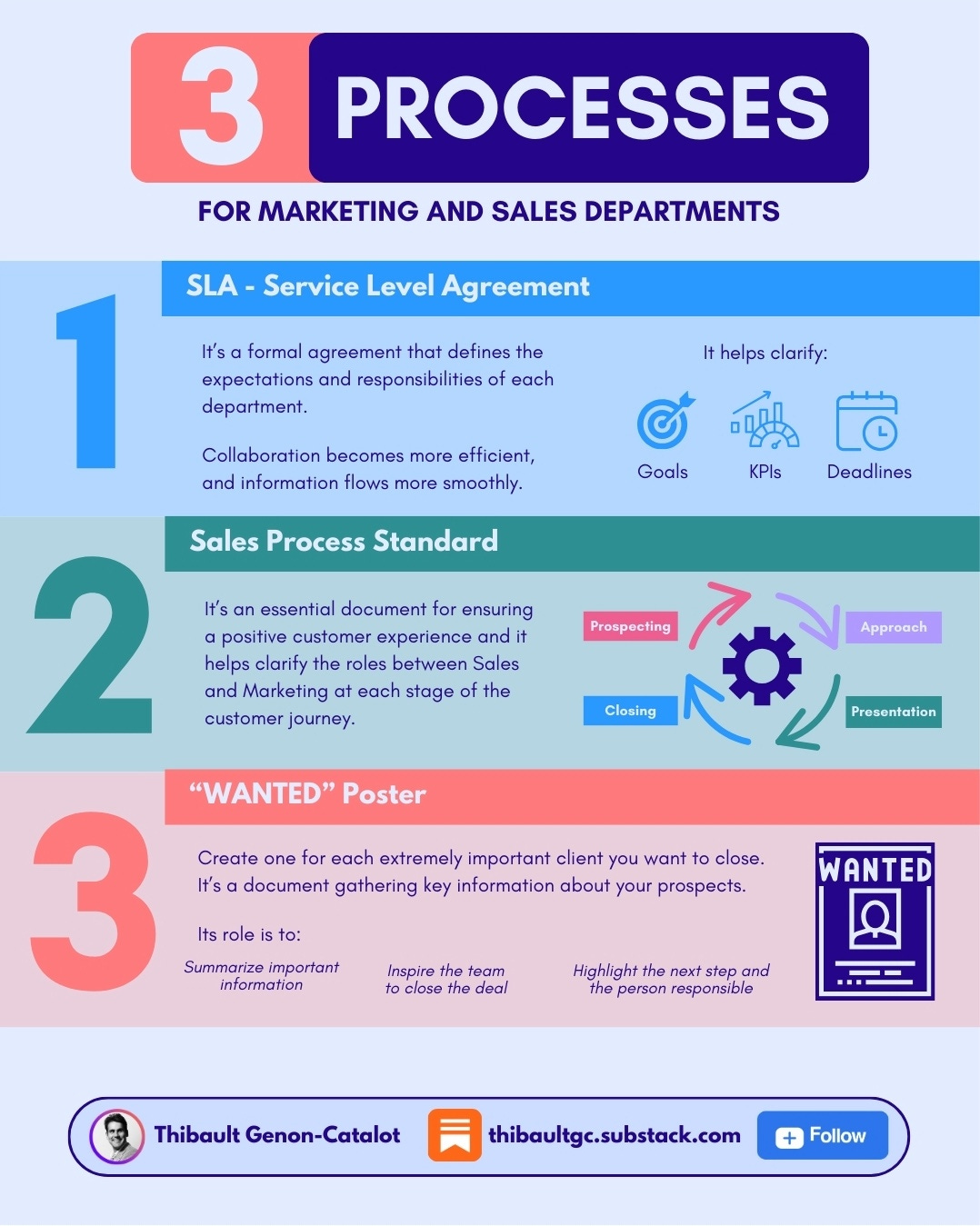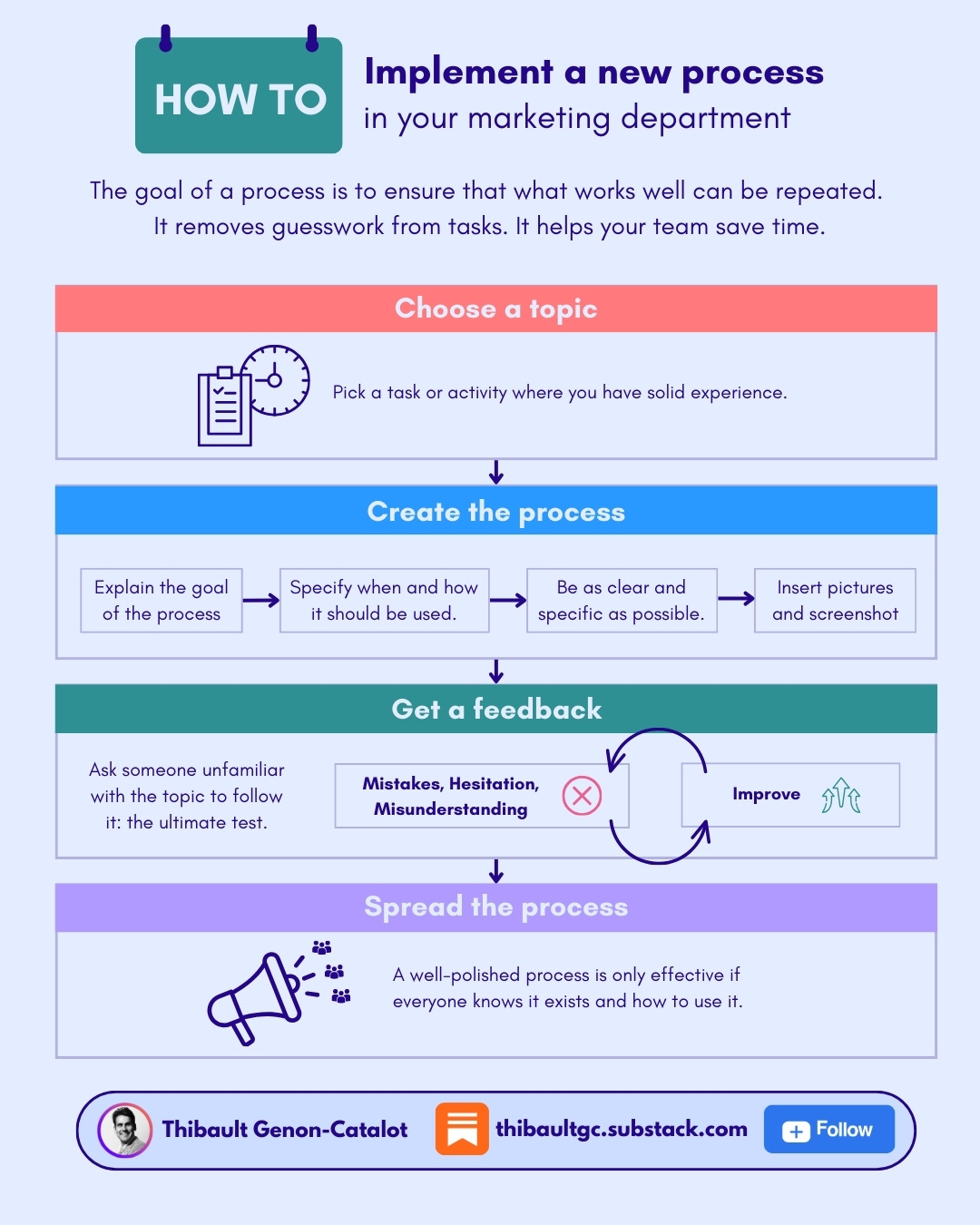How to install processes in your Marketing Department? and Why?
Your marketing is all over the place.
Your team is stressed, and every campaign feels like it's barely holding together.
They’re exhausted, constantly memorizing information they shouldn’t have to.
Roles aren’t clear, so when something goes wrong, the blame game starts.
You’re losing time and critical information between steps.
Worse, when something does work, you can’t repeat it because there’s no record of how it happened.
These issues come from not having clear processes.
It’s not just frustrating — it’s costing you time, money, and opportunities.
But here’s the good news: these problems can be fixed.
With the right structure and a clear methodology, you can turn chaos into order.
You’ll align your team, save time, and get better results.
In this guide, I’ll show you how to set up these processes in your marketing department, so you can stop scrambling and start seeing real, consistent progress.
This article was co-written with Rémi Giudicelli, Global Head of Marketing at CargoAi.
1. Why you NEED processes to grow and scale ?
Small and Smart companies tend to think that processes kill agility and speed because they slow their execution down.
It’s quite the opposite actually, processes are responsible for both long-term growth and accelerate our operations by reducing the execution time of all the actions we regularly perform that are key to the business, which represent 80% of our daily tasks.
Processes help you tie what you do with the desired outcome for the quarter.
Lots of time in small companies, marketing is stuck on tactical tasks - from creating endless new materials requested by sales, announcing the latest product features and creating tomorrow’s social media posts - ending up losing their sights on what really matters.
Rémi Giudicelli
I’ll give you 7 reasons why you NEED to implement more processes in your organization in order to grow and scale.
1 - Processes guide your execution by showing the best way to do it.
It doesn’t slow you down.
It helps you execute tasks quicker because you know what you are doing.
You are doing it the best way possible.
2 - Processes prevent you from missing valuable steps or actions that are important for your team.
In a process there are always added steps, to confirm, validate, and secure what we are doing.
These NECESSARY actions have been built to avoid dangerous consequences.
AND making sure everybody has access to the same exact information.
3 - Processes clarify roles and responsibilities of each team member.
On a daily basis, teams make a lot of decisions.
Sometimes the decisions have to be made with little informations.
In these recurrent situations, making sure everybody knows its own role is extremely important.
4 - Processes facilitate communication between departments.
A process is an official document stating what should be done by who in a specific situation.
Based on this document departments can discuss and exchange ideas.
It’s a reference used in case of disagreements.
5 - Processes are the best way to onboard new team members.
It’s a good way to show a new coworker how things get done here.
It’s a quick, efficient and cheap onboarding.
6- Processes are a reflection of your marketing maturity.
The number of processes in your organization means a lot of things.
Companies with great experience in marketing document everything.
They keep a record of everything they do.
7 - Processes are the best tools for continuous improvement and scalability.
By standardizing workflows, you create a baseline that can be regularly reviewed and optimized.
With time, you’ll be able to replicate successful strategies across different markets.
That growth won’t be just a stroke of luck but a sustainable outcome.
By implementing more processes, your department will run like a well-oiled machine.
Every team member will know exactly what to do, when to do it, and how to do it.
No more missed steps.
No more confusion.
Just consistent, scalable results.
This is the key to ensuring your company’s long-term success.
Now let’s have a look at what kind of processes you can implement this week in your organization.
You don’t have time to read the entire article ? Join us on Friday September 27 ⬇️
2. Fundamental Processes for Marketing and Sales
This article focuses mostly on Marketing & Sales.
These two departments have a "cat and dog" relationship that is both fascinating and amusing, making them a perfect example of areas to improve within a company.
Here are listed a 7 common situations in the daily life of an organization, that you will recognized for sure.
These situations show flaws that slow down your organization and kill its performance.
For each situation you’ll find an associated process to implement in order to fix the flaw.
Here you go :
If Sales are always complaining about marketing
→ You need to create an SLA - Service Level Agreement
It’s a formal agreement that defines the expectations and responsibilities of each department.
It helps to clarify :
Goals,
KPIs
Deadlines.
You can integrate what the Marketing Department should deliver to the Sales Team :
What
How
When
Where
by Whom to who
By implementing this process,
Collaboration becomes more efficient, and information flows more smoothly.
This document can include definitions such as:
What is a Marketing-qualified lead?
What is a Sales-qualified lead?
For example :
The marketing team may commit to generating a certain number of qualified leads,
while the sales team commits to following up on them within a specified timeframe.
If your team loses informations between sales steps and responsibilities are not clearly defined throughout the Sales Process
→ You need to create a Sales Process Standard
It’s an essential document for ensuring a positive customer experience and minimizing lost deals due to internal communication errors.
It helps clarify the roles between Sales and Marketing at each stage of the customer journey.
Here is the methodology you should implement : Create the Sales Process through the eyes of your prospects…
You NEED to build this Sales Process during a brainstorming session, like a workshop.
Start by describing all the steps your prospect goes through when purchasing from your company.
For each of these steps specify the tools used, like your website, Teams (if it’s a call), or your CRM.
Then describe what is the goal of the customer.
What is he trying to achieve ? What is his purpose ?
Under each goal, write his pain points : What problems is he experiencing ?
Specify the person or department in charge of this specific step.
It’s better to have an external aid of a Marketing Consultant to conduct the workshop,
ask the right questions to the team members,
and draw their attention to important points.
He will be able to spot inconsistencies and determine what is doable or unattainable.
If Priorities are not well stated in the Sales Team
→ Create a “WANTED” Poster
Imagine a “wanted poster” like in the westerns movies.
The Sales department will create one for each extremely important client they want to close.
It’s a document gathering key information about these prospects.
It helps align the entire team, enabling them to go all out and give the deal the best chance of success.
Its role is to:
Summarize important information
Inspire the team to close the deal
Highlight the next step and the person responsible
Tip: You can adjust the Western style depending on how fond you are of Clint Eastwood.
If you change your Marketing Tactics every two weeks, and your team has no idea what they are doing
→ Create a Marketing Strategy…
I won't elaborate on the topic, as I already post extensively about it as a Marketing Strategist
What you need to understand is that having a Marketing Strategy is the difference between Marketing actions that yield results and those that never take off.
Here are the 5 steps you need to go through when creating a Marketing Strategy :
Situation Analysis
This step is crucial for your Marketing Strategy because it is on this analysis phase that the entire strategy will be built.
This is where you gather all the important information, here is a short list :
- Mission
- Vision
- SWOT
- Competitor analysis
- Market trends
- Social media analysis
- Customer testimonials
- Acquisition channel analysis
- Previous marketing actions
- Marketing budget & expenses
- Value propositions
SMART Goals
Define 2 to 3 SMART objectives; they should represent your company's priorities.
For my clients, I set 3 types of objectives:
Visibility and Awareness
Business Development
Structuring of the Marketing Department
Don't forget to use the SMART method to define each objective!
Specific
Measurable
Achievable
Relevant
Time-bound
Strategy
Defining a strategy is much simpler than you think.
A strategy can be summarized in one sentence.
It is not specific, doesn't provide exact figures, and describes more of an approach or a concept.
It answers the questions:
How am I going to achieve it?
In what direction am I heading?
Tactics
Detail the concrete actions that will allow you to achieve your objectives through your strategy.
Tactics represent the operational side of your Marketing Strategy.
I recommend linking each action to one of your objectives.
Control System
The progress of each objective should be tracked using specific KPIs.
This is where the control system comes into play.
Create a control system (Excel) and a visual management tool so that this progress is visible to everyone and motivates team members to achieve the goals.
Set up the cadence and dance the beats of your own rhythm
Talking from experience, a key differentiator is their cadence — sometimes called business rhythm.
Once you’ve set up your strategy, your campaign, you often think that’s all it takes — until you wake up 12 months later and lots of these things are left unachieved and some metrics didn’t evolve as planned.
The way I like to make it concrete — a.k.a. make the strategy come to life — is by setting a specific cadence and having selected reviews with each having their own objective:
3-5 year roadmap: (this has been discussed above)
Quarterly Business Review:
Set up a 2-hour meeting and aim to set the OKRs/objective of the coming quarter. The audience should include people from all departments.
I won’t explain too much about OKRs but if you want more info about OKRs, I’d recommend the book “Measure What Matters” from John Doerr.
Ideally, you should plan around product launches, key messages or campaigns to push for the quarters or see what other metrics shall be improved (ROAS, lead generation, funnel conversion rate, churn winback or any other metrics depending on your business).
The OKRs shall be discussed as a business team altogether and never be planned by a single department.
Monthly Review:
1-hour meeting shall be enough (but can be extended if your team starts to get bigger).
The main difference between a QBR and a MBR is to see how we trend towards the QBR OKRs.
The audience should be mainly the marketing team but a summary shall be shared with the wider company. I like to add 2 parts of “what worked well” and “what did we learn” so that your team can have a time to share and reflect on what happened the month before.
My personal tip is also to take this time to recognize and reward outstanding performance from key members to boost their morale and create a team spirit.
Weekly Standup:
15 to 30-min meeting should be more than enough — typically on Monday. I recommend having two parts:
(1) metrics review where you review the trend of those measured KPIs that matter (2) tasks for the week with big rock projects and the “small pebbles”.
I ask the team to just add their updates very quickly on a dashboard (we use whiteboards) and I use these meetings very tactically to unblock any issue the team is facing while ensuring the team can keep their eyes on the Quarterly Objectives (the QBR ones).
If you don’t remind them about it, they may spend too much time on the smart pebbles - known as the death of the marketing performance by a hundred cuts. On the other hand, I have seen dramatic improvements in team outputs when we attack our weeks with intention rather than being reactive and waiting for instructions from others.
I learned and applied this as a Chief of Staff to steer multiple leadership teams and their P&L and it always worked wonders. Call me micro-manager, but my own belief is that wars are won thanks to people working in the trenches making daily micro decisions that could decide the fate of daily battles. Not because someone did a great speech one day — unlike what most stories try to tell you.
Everything can be modified at will depending on your company. I’ve seen one who used to do a big meeting every 4 months instead of quarterly, I’ve seen those who prefer to have larger weekly meetings, like what Apple did many years back.
by Rémi Giudicelli
If your marketing campaigns are inconsistent, deadlines are missed, or the team is unsure what needs to be done and when
→ Create a Marketing Campaign Calendar
If your marketing campaigns are all over the place, deadlines are slipping, or your team doesn’t know what’s happening when, then it's time to get organized.
A Marketing Campaign Calendar aligns your team, keeps everyone on track, and ensures your campaigns are consistent and timely.
Follow this step by step process :
Choose a tool that suits your team's needs (Google Calendar, Outlook, Trello, Asana, or Monday.com)
Define clear objectives for each campaign (Are we aiming for brand awareness, lead generation, product launch ?)
Break down each campaign into key phases :
Planning phase (research, ideation)
Creation phase (content, visuals, ads)
Distribution phase (publishing, advertising, social media push)
Post-campaign analysis (KPI tracking, reporting)
Set realistic deadlines for all tasks and milestones.
Add important dates and events (Holidays, Industry-specific events, Product launches or company events)
Align everything with your overall strategy.
Assign tasks to the right people
Who is responsible for each action.
What the deliverables are.
When they are due.
Track performance using KPIs.
Hold regular meetings to review progress.
Now you print it and you hang it up all over the walls of your company !
If your team doesn't know who they’re targeting, or is creating content that doesn't resonate with prospects
→ Create your Persona Profiles.
If your team isn’t sure who they’re targeting or the content isn’t hitting the mark, you’ve got a persona problem.
Persona Profiles are the answer.
They help your team understand your ideal customers and create content that actually connects.
They are created collaboratively.
Their purpose is to be printed and visually accessible to the Marketing and Sales teams.
Here is the process you need to follow :
1. Gather your team for a collaborative session.
2. Identify the key characteristics of your ideal customers.
3. Define their goals, pain points, and challenges.
4. Add demographic information like age, job title, and location.
5. Highlight the tools they use and the platforms they frequent.
6. Make the profiles visually accessible to the whole team.
7. Regularly update the profiles as your audience evolves.
Now you must share the profiles with both marketing and sales teams !
If the sales team struggles to find accurate product information or key service details during pitches
→ Create a Product and Services Data Room
It’s a Database of all marketing content (case studies, testimonials, product sheets, etc.) that Sales can use to support their efforts.
It also includes logos in all possible formats and creatives for LinkedIn posts.
Additionally, there are presentation templates for creating sales proposals or other documents.
It centralizes all the crucial info, so your team always has what they need at their fingertips.
Follow this process :
Gather all relevant product and service information.
Organize the data into categories for easy access.
Include key details like pricing, features, and benefits.
Add customer testimonials and case studies.
Store it in a shared online space accessible to the entire team.
Update the information regularly to keep it accurate.
Make it searchable for quick retrieval during pitches.
Now your sales team will have everything they need at your fingertips and they will LOVE marketing for that.
3. How to create your own process
A process is a reference document that shows the best way to do something.
The main goal of a process is to reiterate what worked well because you kept track of how you did it.
Learning and documenting are the keywords.
You can create a process for whatever is important to your company.
Start by choosing something that you do regularly and on which you have a good experience.
I advise you to go through this guide with the team members that are most interested by the topic.
Step 1 : Create a word document or google doc.
On the first page, add a title.
Explain the goal of this process and what it is about.
Then add in what circumstances it can be used.
Add who can use it, or which department.
On the top of the page, add when the latest version was modified and who did it.
Step 2 : Detail step by step the process that you want to describe.
Try to be as detailed as possible, do not use subjective words, use a neutral tone.
Add pictures or screenshots as much as you can.
A detailed process can easily take 5 to 7 pages depending on the topic.
A process if the occasion of sharing, setting in stone your experience and knowledge about a specific topic.
It should show what is the best way to do something.
That’s why you’ll start with what you have mastered for years.
Step 3 : Ask someone without any knowledge of the topic to read the process and do the actions listed.
Everytime the person hesitates, make a mistake, or goes back to his previous action,
is not his fault, it’s a proof the process has to be improved in this particular step.
Why is it important to get help from someone unfamiliar with the topic ?
It’s the ultimate test for your process.
It shouldn’t be subject to interpretation, it should be as clear and easy to read as the instructions on a fire extinguisher.
A new coworker can integrate your team and have no clue how to use your tools.
You can come back from a vacation, and make a careless mistake.
The possibilities are infinite.
Step 4 : Spread the word
When your process is smooth.
It’s time to share it with the persons involved.
A well-polished process is of no use if nobody knows it exists.
Make it accessible and communicate it to your coworkers on different channels.
And make sure that they get the information - ask them.
Conclusion
Overall, your organization needs to move from being reactive to being proactive. And processes is one of the biggest levers to do that change.
Rémi Giudicelli
Installing processes in your marketing department is a game changer.
It brings structure, clarity, and efficiency to your team.
Instead of chaos, everyone knows exactly what to do, and when.
No more missed steps or confusion.
With the right processes in place, you’ll see smoother operations and, more importantly, consistent, scalable results.
As a marketing consultant, I help organizations structure their marketing department.
I design the right processes, by auditing their organization.
Unlock their team’s full potential, with customized training sessions and coaching.
And lay the foundations for their success.
Feel free to contact me if any of the situations above sound familiar to you.





